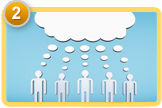It's time to get connected!
Many health care providers are already realizing that electronic health records (EHRs) can help them provide higher quality and safer care for their patients, and can also reduce paperwork and increase overall practice efficiencies. Other benefits, such as improving care coordination, will come when more providers get connected and health information exchange expands. Take the first step toward EHR implementation today!
The following step-by-step process – or road map – organizes the training, tools and standard operating procedures that are leading practices for each phase of successful EHR implementation. These processes and tools have been developed by staff of the 62 Regional Extension Centers (RECs) who are working with thousands of providers to select and implement EHR software. The roadmap provides a framework for aligning the tasks required to meet the unique needs of individual practices.
Over the coming months, the RECs will continue to share their experiences from the field and the resulting leading practices and tools that can be used throughout all phases of the Practice Transformation Roadmap. Please check back often for more EHR implementation information and resources.
Practice Transformation Roadmap – Step-by-Step Process

Assess Your Practice Readiness
(people, clinical process, business process, technologies…)
Plan Your Approach
(practice goals, personal goals, workflows, pace of implementation…)
Select or Upgrade to a Certified EHR System
(software, interfaces, integration…)
Conduct Training and Implement an EHR System
(migration, privacy, security, go-live…)
Achieve Meaningful Use and Quality Improvement
(quality improvement, care coordination…)





